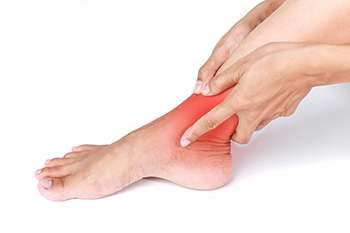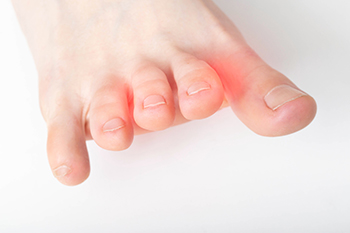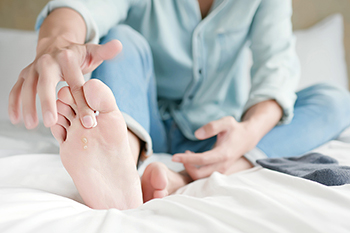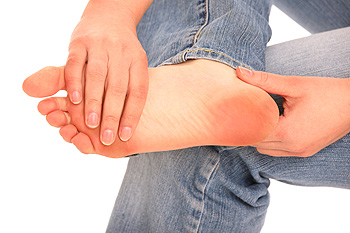Items filtered by date: May 2022
Common Causes of Ankle Pain

Women can be affected by ankle pain more than men. Typically, the soft tissues are damaged in the foot and ankle often resulting in pain and discomfort. Some of the conditions linked to ankle pain can include Achilles tendonitis, an ankle sprain, or plantar fasciitis. Achilles tendonitis can cause pain in the back of the ankle as a result of overuse. An ankle can be sprained if it stretches beyond its normal range of motion. This can occur from stepping off of a curb and landing incorrectly. Plantar fasciitis occurs when the plantar fascia, which is located on the bottom of the foot, becomes inflamed. This may cause tenderness in the ankle. Relief from ankle pain may be found by practicing specific exercises designed to strengthen the ankles. Additionally, wearing shoes that fit correctly and elevating the feet frequently may help to reduce existing pain and swelling. If you have ankle pain for any reason, please contact a podiatrist who can pinpoint the exact cause and offer correct treatment techniques.
Ankle pain can have many different causes and the pain may potentially be serious. If you have ankle pain, consult with Dr. Mark Gagnon from Advanced Podiatry. Our doctor will assess your condition and provide you with quality foot and ankle treatment.
Ankle pain is any condition that causes pain in the ankle. Due to the fact that the ankle consists of tendons, muscles, bones, and ligaments, ankle pain can come from a number of different conditions.
Causes
The most common causes of ankle pain include:
- Types of arthritis (rheumatoid, osteoarthritis, and gout)
- Ankle sprains
- Broken ankles
- Achilles tendinitis
- Achilles tendon rupture
- Stress fractures
- Tarsal tunnel syndrome
- Plantar fasciitis
Symptoms
Symptoms of ankle injury vary based upon the condition. Pain may include general pain and discomfort, swelling, aching, redness, bruising, burning or stabbing sensations, and/or loss of sensation.
Diagnosis
Due to the wide variety of potential causes of ankle pain, podiatrists will utilize a number of different methods to properly diagnose ankle pain. This can include asking for personal and family medical histories and of any recent injuries. Further diagnosis may include sensation tests, a physical examination, and potentially x-rays or other imaging tests.
Treatment
Just as the range of causes varies widely, so do treatments. Some more common treatments are rest, ice packs, keeping pressure off the foot, orthotics and braces, medication for inflammation and pain, and surgery.
If you have any questions, please feel free to contact one of our offices located in Crestwood, Orland Park, and Summit, IL . We offer the newest diagnostic and treatment technologies for all your foot care needs.
Common Causes of Ankle Pain

Women can be affected by ankle pain more than men. Typically, the soft tissues are damaged in the foot and ankle often resulting in pain and discomfort. Some of the conditions linked to ankle pain can include Achilles tendonitis, an ankle sprain, or plantar fasciitis. Achilles tendonitis can cause pain in the back of the ankle as a result of overuse. An ankle can be sprained if it stretches beyond its normal range of motion. This can occur from stepping off of a curb and landing incorrectly. Plantar fasciitis occurs when the plantar fascia, which is located on the bottom of the foot, becomes inflamed. This may cause tenderness in the ankle. Relief from ankle pain may be found by practicing specific exercises designed to strengthen the ankles. Additionally, wearing shoes that fit correctly and elevating the feet frequently may help to reduce existing pain and swelling. If you have ankle pain for any reason, please contact a podiatrist who can pinpoint the exact cause and offer correct treatment techniques.
Ankle pain can have many different causes and the pain may potentially be serious. If you have ankle pain, consult with Dr. Mark Gagnon from Advanced Podiatry. Our doctor will assess your condition and provide you with quality foot and ankle treatment.
Ankle pain is any condition that causes pain in the ankle. Due to the fact that the ankle consists of tendons, muscles, bones, and ligaments, ankle pain can come from a number of different conditions.
Causes
The most common causes of ankle pain include:
- Types of arthritis (rheumatoid, osteoarthritis, and gout)
- Ankle sprains
- Broken ankles
- Achilles tendinitis
- Achilles tendon rupture
- Stress fractures
- Tarsal tunnel syndrome
- Plantar fasciitis
Symptoms
Symptoms of ankle injury vary based upon the condition. Pain may include general pain and discomfort, swelling, aching, redness, bruising, burning or stabbing sensations, and/or loss of sensation.
Diagnosis
Due to the wide variety of potential causes of ankle pain, podiatrists will utilize a number of different methods to properly diagnose ankle pain. This can include asking for personal and family medical histories and of any recent injuries. Further diagnosis may include sensation tests, a physical examination, and potentially x-rays or other imaging tests.
Treatment
Just as the range of causes varies widely, so do treatments. Some more common treatments are rest, ice packs, keeping pressure off the foot, orthotics and braces, medication for inflammation and pain, and surgery.
If you have any questions, please feel free to contact one of our offices located in Crestwood, Orland Park, and Summit, IL . We offer the newest diagnostic and treatment technologies for all your foot care needs.
Treatment Options Differ for Mild and Severe Morton’s Neuroma

Patients who have pain between the toes may have a condition that is known as Morton’s neuroma. The discomfort can come from the nerves between the toes, and the pain may extend to the ball of the foot. The first symptom of Morton’s neuroma is often a tingling sensation, which will gradually worsen. In severe cases, the pain can become unbearable as pressure is exerted from shoes. Some patients describe the pain as being so unbearable they are anxious about putting the affected foot on the ground. This condition occurs as a result of compressed nerves between the toes, and the surrounding tissue may become thick. People who are most likely to be affected by Morton’s neuroma include women who frequently wear high heels, runners, or anyone with a high arch. In mild cases, treatment can consist of changing the type of shoes worn, and it may help to use orthotics. In severe cases, surgery may be necessary. After the surgery, many times a protective shoe is worn as the healing process takes place. If you have pain in this part of your foot, it is suggested to consult with a podiatrist who can perform a proper diagnosis and suggest the correct treatment for you.
Morton’s neuroma is a very uncomfortable condition to live with. If you think you have Morton’s neuroma, contact Dr. Mark Gagnon of Advanced Podiatry. Our doctor will attend to all of your foot care needs and answer any of your related questions.
Morton’s Neuroma
Morton's neuroma is a painful foot condition that commonly affects the areas between the second and third or third and fourth toe, although other areas of the foot are also susceptible. Morton’s neuroma is caused by an inflamed nerve in the foot that is being squeezed and aggravated by surrounding bones.
What Increases the Chances of Having Morton’s Neuroma?
- Ill-fitting high heels or shoes that add pressure to the toe or foot
- Jogging, running or any sport that involves constant impact to the foot
- Flat feet, bunions, and any other foot deformities
Morton’s neuroma is a very treatable condition. Orthotics and shoe inserts can often be used to alleviate the pain on the forefront of the feet. In more severe cases, corticosteroids can also be prescribed. In order to figure out the best treatment for your neuroma, it’s recommended to seek the care of a podiatrist who can diagnose your condition and provide different treatment options.
If you have any questions, please feel free to contact one of our offices located in Crestwood, Orland Park, and Summit, IL . We offer the newest diagnostic and treatment technologies for all your foot care needs.
Treatment Options Differ for Mild and Severe Morton’s Neuroma

Patients who have pain between the toes may have a condition that is known as Morton’s neuroma. The discomfort can come from the nerves between the toes, and the pain may extend to the ball of the foot. The first symptom of Morton’s neuroma is often a tingling sensation, which will gradually worsen. In severe cases, the pain can become unbearable as pressure is exerted from shoes. Some patients describe the pain as being so unbearable they are anxious about putting the affected foot on the ground. This condition occurs as a result of compressed nerves between the toes, and the surrounding tissue may become thick. People who are most likely to be affected by Morton’s neuroma include women who frequently wear high heels, runners, or anyone with a high arch. In mild cases, treatment can consist of changing the type of shoes worn, and it may help to use orthotics. In severe cases, surgery may be necessary. After the surgery, many times a protective shoe is worn as the healing process takes place. If you have pain in this part of your foot, it is suggested to consult with a podiatrist who can perform a proper diagnosis and suggest the correct treatment for you.
Morton’s neuroma is a very uncomfortable condition to live with. If you think you have Morton’s neuroma, contact Dr. Mark Gagnon of Advanced Podiatry. Our doctor will attend to all of your foot care needs and answer any of your related questions.
Morton’s Neuroma
Morton's neuroma is a painful foot condition that commonly affects the areas between the second and third or third and fourth toe, although other areas of the foot are also susceptible. Morton’s neuroma is caused by an inflamed nerve in the foot that is being squeezed and aggravated by surrounding bones.
What Increases the Chances of Having Morton’s Neuroma?
- Ill-fitting high heels or shoes that add pressure to the toe or foot
- Jogging, running or any sport that involves constant impact to the foot
- Flat feet, bunions, and any other foot deformities
Morton’s neuroma is a very treatable condition. Orthotics and shoe inserts can often be used to alleviate the pain on the forefront of the feet. In more severe cases, corticosteroids can also be prescribed. In order to figure out the best treatment for your neuroma, it’s recommended to seek the care of a podiatrist who can diagnose your condition and provide different treatment options.
If you have any questions, please feel free to contact one of our offices located in Crestwood, Orland Park, and Summit, IL . We offer the newest diagnostic and treatment technologies for all your foot care needs.
Contagious Athlete’s Foot

Tinea is the name of the fungus that causes athlete’s foot. It is a condition that affects the feet and is considered to be contagious. The symptoms that accompany athlete’s foot include itchiness, dry skin, and in severe cases, small blisters. This virus lives and thrives in warm and moist environments, including public swimming pools, locker rooms, and shower room floors. It is suggested that appropriate shoes are worn while in these areas, and it is beneficial to refrain from sharing towels. Additionally, washing and drying the feet thoroughly, and wearing clean socks daily, may help to prevent athlete's foot. There are many treatments for athlete’s foot, and it is advised that you consult with a podiatrist who can determine what the best one is for you.
Athlete’s foot is an inconvenient condition that can be easily reduced with the proper treatment. If you have any concerns about your feet and ankles, contact Dr. Mark Gagnon from Advanced Podiatry. Our doctor will treat your foot and ankle needs.
Athlete’s Foot: The Sole Story
Athlete's foot, also known as tinea pedis, can be an extremely contagious foot infection. It is commonly contracted in public changing areas and bathrooms, dormitory style living quarters, around locker rooms and public swimming pools, or anywhere your feet often come into contact with other people.
Solutions to Combat Athlete’s Foot
- Hydrate your feet by using lotion
- Exfoliate
- Buff off nails
- Use of anti-fungal products
- Examine your feet and visit your doctor if any suspicious blisters or cuts develop
Athlete’s foot can cause many irritating symptoms such as dry and flaking skin, itching, and redness. Some more severe symptoms can include bleeding and cracked skin, intense itching and burning, and even pain when walking. In the worst cases, Athlete’s foot can cause blistering as well. Speak to your podiatrist for a better understanding of the different causes of Athlete’s foot, as well as help in determining which treatment options are best for you.
If you have any questions please feel free to contact one of our offices located in Crestwood, Orland Park, and Summit, IL . We offer the newest diagnostic and treatment technologies for all your foot and ankle needs.
Contagious Athlete’s Foot

Tinea is the name of the fungus that causes athlete’s foot. It is a condition that affects the feet and is considered to be contagious. The symptoms that accompany athlete’s foot include itchiness, dry skin, and in severe cases, small blisters. This virus lives and thrives in warm and moist environments, including public swimming pools, locker rooms, and shower room floors. It is suggested that appropriate shoes are worn while in these areas, and it is beneficial to refrain from sharing towels. Additionally, washing and drying the feet thoroughly, and wearing clean socks daily, may help to prevent athlete's foot. There are many treatments for athlete’s foot, and it is advised that you consult with a podiatrist who can determine what the best one is for you.
Athlete’s foot is an inconvenient condition that can be easily reduced with the proper treatment. If you have any concerns about your feet and ankles, contact Dr. Mark Gagnon from Advanced Podiatry. Our doctor will treat your foot and ankle needs.
Athlete’s Foot: The Sole Story
Athlete's foot, also known as tinea pedis, can be an extremely contagious foot infection. It is commonly contracted in public changing areas and bathrooms, dormitory style living quarters, around locker rooms and public swimming pools, or anywhere your feet often come into contact with other people.
Solutions to Combat Athlete’s Foot
- Hydrate your feet by using lotion
- Exfoliate
- Buff off nails
- Use of anti-fungal products
- Examine your feet and visit your doctor if any suspicious blisters or cuts develop
Athlete’s foot can cause many irritating symptoms such as dry and flaking skin, itching, and redness. Some more severe symptoms can include bleeding and cracked skin, intense itching and burning, and even pain when walking. In the worst cases, Athlete’s foot can cause blistering as well. Speak to your podiatrist for a better understanding of the different causes of Athlete’s foot, as well as help in determining which treatment options are best for you.
If you have any questions please feel free to contact one of our offices located in Crestwood, Orland Park, and Summit, IL . We offer the newest diagnostic and treatment technologies for all your foot and ankle needs.
How Your Arch Is Formed and Why It Might Be Painful

The arch of the foot is critical in dispersing body weight throughout the foot. It also helps a person balance and propel themselves forward when they walk. This important structure made of tendons, bones and ligaments is a combination of three separate arches forming a triangular shape. The transverse arch spans the ball of the foot from side-to-side. The two other arches run from the ball of the foot to the heel: the lateral arch on the outside and the medial arch on the inside of the foot. If you feel pain in your arch it may be due to an inflammation of the plantar fascia tissue which supports the arch (plantar fasciitis). Or, you may have flat feet, which can cause your feet to roll excessively inward when you walk (overpronation) and flatten your arches. An abnormally high arch can also stress your ankle and cause pain. Even an inflammation of the posterior tibial tendon, which connects the inner area of the foot to a calf muscle, can cause pain in the arches. If your arches are painful, it's wise to call a podiatrist who will be able to properly diagnose and treat the area and discuss treatment options.
Foot Pain
Foot pain can be extremely painful and debilitating. If you have a foot pain, consult with Dr. Mark Gagnon from Advanced Podiatry. Our doctor will assess your condition and provide you with quality foot and ankle treatment.
Causes
Foot pain is a very broad condition that could be caused by one or more ailments. The most common include:
- Bunions
- Hammertoes
- Plantar Fasciitis
- Bone Spurs
- Corns
- Tarsal Tunnel Syndrome
- Ingrown Toenails
- Arthritis (such as Gout, Rheumatoid, and Osteoarthritis)
- Flat Feet
- Injury (from stress fractures, broken toe, foot, ankle, Achilles tendon ruptures, and sprains)
- And more
Diagnosis
To figure out the cause of foot pain, podiatrists utilize several different methods. This can range from simple visual inspections and sensation tests to X-rays and MRI scans. Prior medical history, family medical history, and any recent physical traumatic events will all be taken into consideration for a proper diagnosis.
Treatment
Treatment depends upon the cause of the foot pain. Whether it is resting, staying off the foot, or having surgery; podiatrists have a number of treatment options available for foot pain.
If you have any questions, please feel free to contact one of our offices located in Crestwood, Orland Park, and Summit, IL . We offer the newest diagnostic and treatment technologies for all your foot care needs.
How Your Arch Is Formed and Why It Might Be Painful

The arch of the foot is critical in dispersing body weight throughout the foot. It also helps a person balance and propel themselves forward when they walk. This important structure made of tendons, bones and ligaments is a combination of three separate arches forming a triangular shape. The transverse arch spans the ball of the foot from side-to-side. The two other arches run from the ball of the foot to the heel: the lateral arch on the outside and the medial arch on the inside of the foot. If you feel pain in your arch it may be due to an inflammation of the plantar fascia tissue which supports the arch (plantar fasciitis). Or, you may have flat feet, which can cause your feet to roll excessively inward when you walk (overpronation) and flatten your arches. An abnormally high arch can also stress your ankle and cause pain. Even an inflammation of the posterior tibial tendon, which connects the inner area of the foot to a calf muscle, can cause pain in the arches. If your arches are painful, it's wise to call a podiatrist who will be able to properly diagnose and treat the area and discuss treatment options.
Foot Pain
Foot pain can be extremely painful and debilitating. If you have a foot pain, consult with Dr. Mark Gagnon from Advanced Podiatry. Our doctor will assess your condition and provide you with quality foot and ankle treatment.
Causes
Foot pain is a very broad condition that could be caused by one or more ailments. The most common include:
- Bunions
- Hammertoes
- Plantar Fasciitis
- Bone Spurs
- Corns
- Tarsal Tunnel Syndrome
- Ingrown Toenails
- Arthritis (such as Gout, Rheumatoid, and Osteoarthritis)
- Flat Feet
- Injury (from stress fractures, broken toe, foot, ankle, Achilles tendon ruptures, and sprains)
- And more
Diagnosis
To figure out the cause of foot pain, podiatrists utilize several different methods. This can range from simple visual inspections and sensation tests to X-rays and MRI scans. Prior medical history, family medical history, and any recent physical traumatic events will all be taken into consideration for a proper diagnosis.
Treatment
Treatment depends upon the cause of the foot pain. Whether it is resting, staying off the foot, or having surgery; podiatrists have a number of treatment options available for foot pain.
If you have any questions, please feel free to contact one of our offices located in Crestwood, Orland Park, and Summit, IL . We offer the newest diagnostic and treatment technologies for all your foot care needs.

